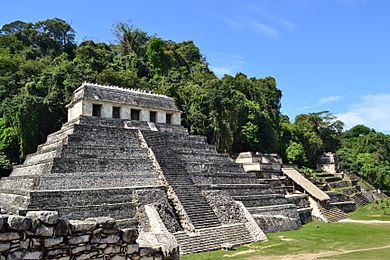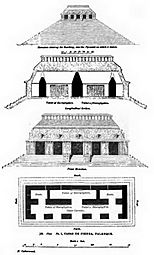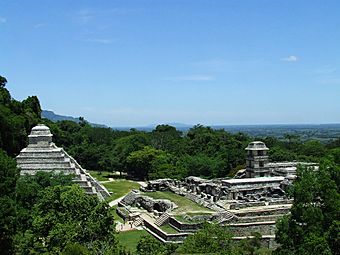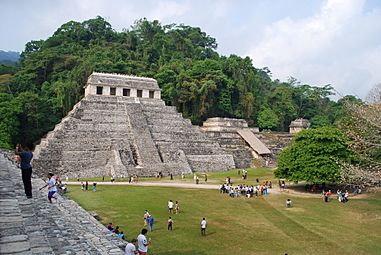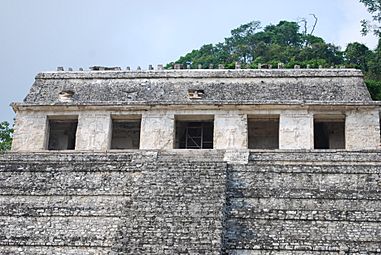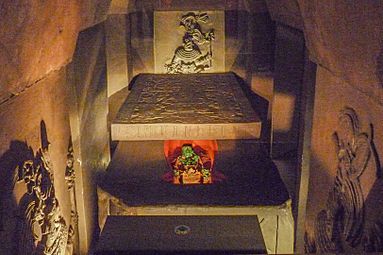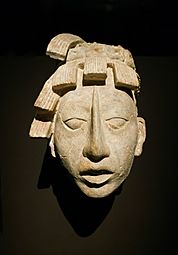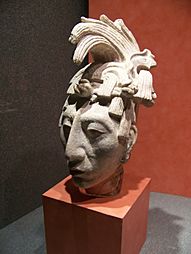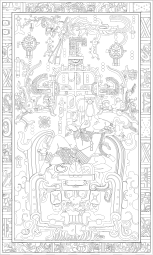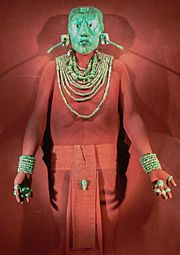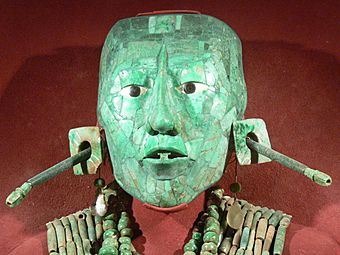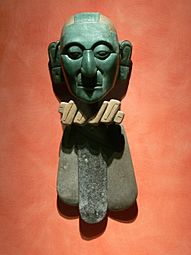Temple of the Inscriptions facts for kids
The Temple of the Inscriptions is a huge pyramid in an ancient Maya city called Palenque. This city is in what is now Chiapas, Mexico. The Maya people built this amazing structure as a special tomb for their ruler, Kʼinich Janaabʼ Pakal. He was the ajaw (king) of Palenque for almost 70 years in the 600s AD.
Pakal started building the temple near the end of his life. His son, Kʼinich Kan Bahlam II, finished it after Pakal passed away. The Temple of the Inscriptions is a very important place for learning about the ancient Maya. It has many hieroglyphic writings, cool carvings on its walls, and amazing things found inside Pakal's tomb.
Contents
What is the Temple of the Inscriptions?
The Temple of the Inscriptions is made of two main parts. First, there's a "temple" building at the very top. This temple sits on an eight-stepped pyramid. So, the whole structure has nine levels in total.
The front of the temple has five entrances. Around these entrances are tall, flat stone panels called piers. These piers have both carved pictures and the special Maya writing that gave the temple its name. Inside the temple, a secret stairway leads down to a hidden room. This room is the crypt where Pakal's sarcophagus (a stone coffin) is kept.
History of the Temple of Inscriptions
The Temple of the Inscriptions was finished shortly after the year 683 AD. King Pakal himself began the building work. However, his son, Kʼinich Kan Bahlam II, completed the pyramid and added all the final decorations.
People had been visiting and studying Palenque for over 200 years. But Pakal's tomb remained a secret until 1952. A Mexican archaeologist named Alberto Ruz Lhuillier found a stone slab on the temple floor. When he moved it, he saw a stairway filled with rocks and dirt. It took two more years to clear the stairway. Finally, in 1954, they discovered that it led right into Pakal's amazing tomb!
Carved Piers of the Temple
The temple has six tall, flat panels on its front, called piers. These are named A through F. Each pier has carvings, writings, or both. These carvings were made from plaster called stucco. Piers A and F have only Maya writing on them. Piers B through E show people holding a small, baby-like figure. This figure has a snake for one of its legs!
-
An old drawing of the temple's plan by Frederick Catherwood
Pier A: Ancient Text
Pier A is covered only with Maya writing. Today, only eleven parts of the writing can still be seen. One word that is clear means "capture." But we don't know who or what was captured because the other words are too damaged to read.
Pier B: The God K Figure
Pier B shows a human figure holding a small "child" figure. This child is thought to be God K, a Maya god. One of God K's legs is a snake.
The human figure is actually life-sized, about 165 cm (5.4 feet) tall. It wears a fancy feather headdress and a jaguar skin skirt. The figure's head is missing now due to damage. The "child" figure, God K, has one human leg and one snake leg. The human leg has six toes! This special feature might be a hint about Pakal's son, Kan B'alam II. He was known to have six fingers on one hand and six toes on one foot.
Pier C: The Royal Connection
The person standing on Pier C is likely a woman. Many experts believe it is Lady Zac-Kuk, who was Pakal's mother. There's a hollow tube, called a psychoduct, that goes from the outside of the temple directly into Pakal's tomb. This tube and a stone band connected to it look like an umbilical cord. Since this "umbilical cord" connects the figure on Pier C to Pakal's tomb, it supports the idea that the figure is his mother. It could also show the importance of the royal family line.
Pier D: More About God K
Pier D gives us more clues that the "baby" figure is indeed God K. On this pier, the "baby" figure wears a special "axe" or "flare" on its forehead, which is a sign of God K. This carving of God K is more complete than on the other piers. There are also three vertical cuts on the god's back. We know these cuts were made on purpose, but their meaning is still a mystery.
Pier E: King Kan Bahlam I
The standing figure on Pier E is probably Kan Bahlam I. The fancy headdress worn by this figure has words that say "chan-bahlum." This is likely not Kan B'alam II, as he is thought to be the God K figure. Kan B'alam II, who was Kan B'alam I's great-great-grandson, finished decorating the temple. By showing his ancestor, he was likely proving his right to be king. He wanted to show his connection to his family, including his father and grandmother.
Pier F: A Mysterious Title
Pier F has only one block of writing left today. It seems to contain a title that might mean "dead rabbit." After that, it says "Kinich Kan-B'alam," which is a name and title. Then there's another unknown word, and finally, the word for Palenque.
Bright Colors of the Piers
Imagine how colorful the piers must have been! Most of the color has faded, but some can still be seen. The piers were once painted with bright red, yellow, and blue. A thin layer of light red paint was put on all the stucco carvings while the plaster was still wet. This helped the color stick to the building. Because the temple was painted many times, you can see layers of paint between layers of stucco.
The color blue was used for things related to the gods and the sky. Yellow was linked to Xibalba, the Maya underworld, and jaguars. So, the jaguar skirts were painted yellow.
The Inscription Tablets
The Temple of the Inscriptions gets its name from three large stone tablets inside the temple. They are called the East, Central, and West Tablets. These tablets have a very long Maya inscription, with 617 hieroglyphs! They talk about the idea that important events from the past will happen again on the same calendar date.
The tablets record many events from Pakal's life. The last two columns on the tablets announce his death and name Kan B'alam II as his heir. All the tablets, except for those last two columns, were finished while Pakal was still alive.
Pakal's Hidden Tomb
Tomb Structure
The architects who built Pakal's tomb were very clever. To stop the tomb from collapsing under the huge weight of the pyramid above it, they used special building techniques. They designed the hut-shaped room with cross vaulting and strong, hidden supports called buttresses.
Amazing Finds in the Tomb
Pakal's tomb held many important and beautiful things.
Pakal's Sarcophagus
One of the most amazing finds was the lid of Pakal's stone coffin, the sarcophagus. The carving on the lid shows Pakal lying on top of an "earth monster." Below him are the open jaws of a jaguar, which stands for Xibalba (the Maya underworld). Above him is a Celestial Bird sitting on the Cosmic Tree. This tree holds a snake in its branches. So, the carving shows Pakal between two worlds: the heavens and the underworld.
The sarcophagus also shows Pakal's ancestors, lined up going back six generations. Only one person, Merle Greene Robertson, has ever photographed the sarcophagus lid. She had to be lowered from the ceiling to take the pictures! After that, the tomb was sealed up again and has not been opened since.
-
A copy of Pakal's sarcophagus at the Museo Nacional de Antropología in Mexico
Other Treasures
Pakal's death mask is another incredible treasure found in his tomb. The mask's face is made entirely of beautiful jade. Its eyes are made from shells, mother of pearl, and shiny obsidian.
Several smaller jade heads were also found packed inside Pakal's sarcophagus. And a stucco portrait of the king was discovered right under the base of his coffin.
See also
 In Spanish: Templo de las Inscripciones (Palenque) para niños
In Spanish: Templo de las Inscripciones (Palenque) para niños


